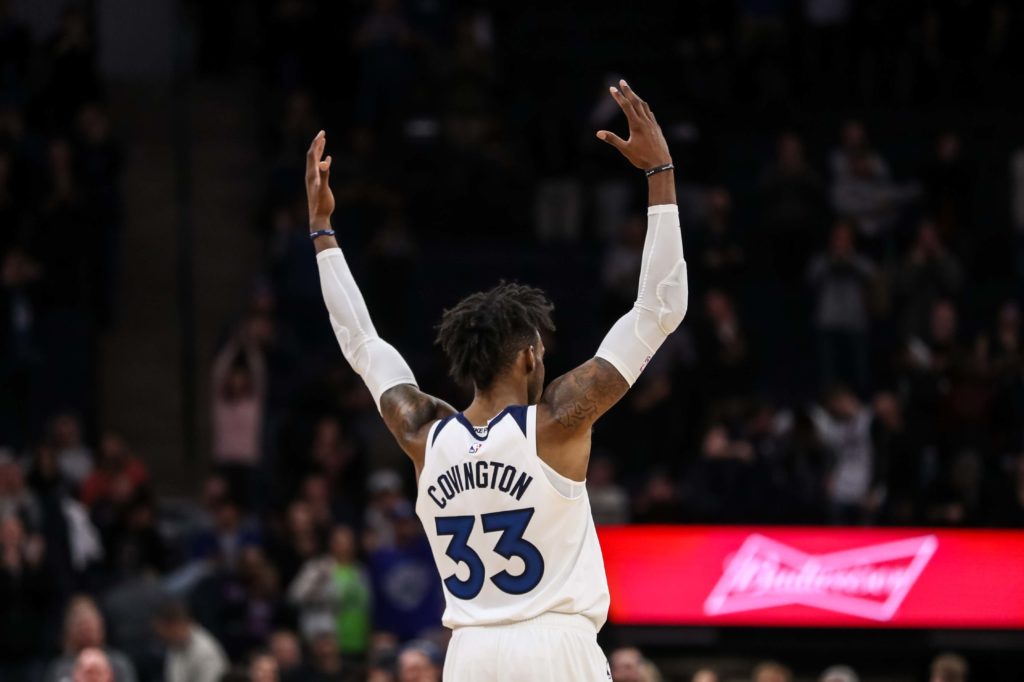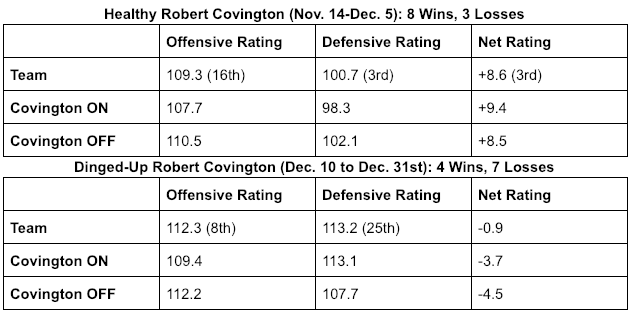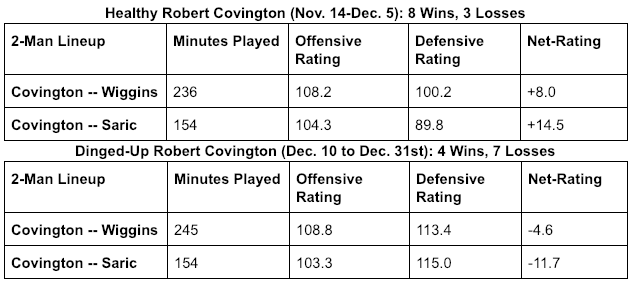There’s something that feels a lot like apathy sinking in around the 2018-19 Minnesota Timberwolves season. The genesis of this emotion, I believe, is born out of the notion that it just doesn’t really feel like anything is changing. It’s been two months since Tom Thibodeau was fired and while this has changed the general vibe around the team — for the better — the on-court product remains the same: below-average. The playoffs ain’t happenin’.
However, to be the jester dancing in the rain for a minute, I do think change is coming. Maybe Robert Covington’s return can inspire something that feels a little like enthusiasm.
At Monday afternoon’s practice, Ryan Saunders nodded towards the far court at the Wolves’ practice facility where Karl-Anthony Towns and Covington were the last two players left on the floor, simulating some sort of defensive coverage with Randy Wittman (who is serving as special assistant to Saunders). While Covington stood slumped over in a defensive squat signaling something to Towns, Saunders told the media he expects the prized jewel of the Jimmy Butler trade to return “hopefully this week.”
Well, the Wolves play two more games this week — a double-dip against Washington Saturday and New York Sunday. If Covington does return this weekend, or whenever, it’s safe to say he will bring a change. What we learned from Covington’s play at the end of the 2018 calendar year, is that he serves as a barometer for this team and that the Wolves defense goes as he goes.
Will Covington save the day for the Wolves and bring them to the playoffs? Again, almost certainly, the answer to that question is no. That said, other questions that will inform the immediate future of a franchise that still feels like it is on the rocks will certainly be informed by Covington’s return.
This is particularly true for Towns, who certainly does not care about the Wolves lottery ping-pong ball count as much as Twitter does. The return of his friend is important.
“Me and Cov have always been really close,” Towns said once he made his way over to the media scrum after Saunders. “I’m just glad he’s feeling good and feeling better… I miss him, the dinners and everything.”
Towns, along with the rest of the roster, feel the stagnation that has sunk in during Covington’s absence. They too hunger for change. What exactly that change looks like is a bit ambiguous. But here are a few things I’ll have my eyes on:
The Perception of KAT’s Defense
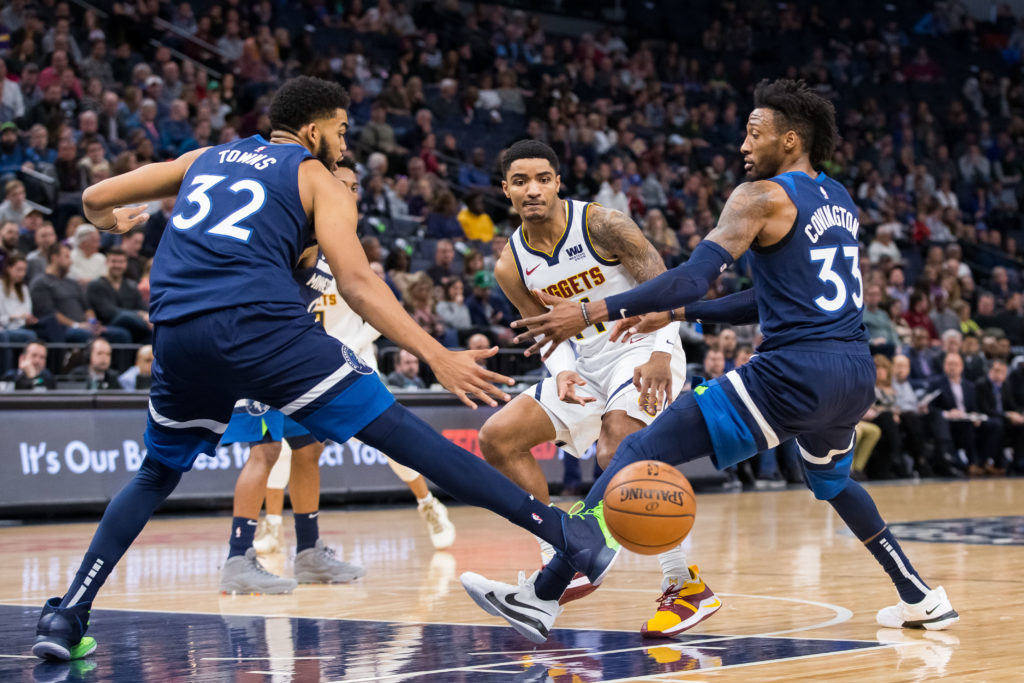
Covington is a defensive medic; he’s able to, amidst the flow of a possession’s 24-second battle, stop the bleeding. Occasionally, this manifests in a block, interception or his patented rip-away. More frequently, however, Covington coagulates defensive possessions without forcing a turnover. He does this simply by positioning himself for deterrence — a lateral slide-step with arms sprawled when he is off the ball or a forced re-direction when he is defending the dribbler. Covington is a compilation of things that lead to far fewer full-on breakdowns.
For a seven-footer, like Towns, who functions as a team’s tentpole, their perception is often dependent on how the four surrounding defensive teammates are performing that deterring. A missed slide-step by a teammate here, a lazy arm-placement there or just a blown rotation can make the center look cement-footed. Towns wears the trickle-down effect of what has been a broken defense these past two months.
Over the past nine weeks that Covington has been sidelined, these slip-ups happened all the time. The breakdowns are unacceptable when you ask Saunders and his players to detail and are certainly the reason the Wolves have ranked 23rd in the league in defensive rating during Covington’s absence.
“Our rotations,” were the problem, Tyus Jones said, after the Wolves most recent three-game road trip where Jones and crew gave up, on average, 129 points per game. “We were a second or half-step late on rotations. Just not being there for our teammate, not having their back, not following the gameplan for the full 48.”
With a medic in Covington, it would be shocking to see these types of trends continue. Someone losing a half-step isn’t the end of the world when Covington is out there. RoCo’s awareness along with the space he fills with his length and quickness can and will mitigate those rotation slip-ups. But perhaps of more importance, as it pertains to the perception of KAT, is Covington’s presence affecting the way the Wolves utilize their center defensively. In the 22 games RoCo has flanked KAT this season, the Wolves center took a different form.
At least under Thibodeau (Covington has not played in a game under Saunders), the Wolves were using Towns, and the other bigs, in a far more aggressive manner on defense. A faith in Covington’s ability to deter when on-the-ball — often in a trap or hard hedge — encouraged the idea of not needing to have Towns live in the lane. Towns and Covington can trap together.
This play, from what I think was the single-best defensive game the Wolves have ever played in the KAT era, I’ve referenced numerous times. I almost like that it actually ends with a Kemba Walker bucket because it backwardly exacerbates the impossibility of a player — even of Walker’s caliber — to score consistently with this type of defense thrown at them. After that bucket, Walker only converted four of his next 14 field-goal attempts that night.
When we talk about defensive perception in today’s NBA, particularly as it pertains to bigs, the aesthetic of aggression makes a huge difference. Even if the stylistic changes with Covington in tow don’t render statistical improvements (unlikely), seeing KAT jump out onto the perimeter — perhaps switching — will open the minds of those judging him. The sample size of Towns simply doing things differently will grow and thus intrigue will be born out of the way we lust over the diversification of skillsets. I believe this can change the perception of the 23-year-old big man.
Watch, one of those national outlets will begin to drool over Towns’ defense after a few weeks of playing alongside Covington. The KAT is Playing the Best Defense of his Career feature is coming.
“It’s a team thing,” Towns said Monday. “But I think [Covington will] solve a lot of issues we have defensively with his length and his defensive prowess. Just his I.Q. and obviously he’s a first-team all-defensive player for a reason.”
Josh Okogie’s Future on the Wing
Covington’s presence comes with an impact on his teammates that, of course, extends beyond the bigs. Other than Towns, the most informative difference could come from what can be learned about Covington’s pairing alongside Josh Okogie.
When RoCo was really rolling (read as fully-healthy) in his first 11 games with the team, the Wolves rattled off eight wins. In those three weeks, before Covington missed his first game of the season (Dec. 8), the Wolves defense surrendered 12 fewer points per 100 possessions than they have in the 28 Covington-less games. However, in that run, Covington and Okogie only shared the floor for 13 total minutes. Which is to say, we don’t really know what it will look like when the team’s (perhaps) two best defenders are out there together.
When Covington was healthy, he was the most-frequent point-of-attack (POA) defender. When Covington went down, Okogie not only took over RoCo’s starting spot but his functionality at the POA.
Saunders has said he prefers his POA defender to instigate a “no middle, no paint” strategy. “If he’s in the center of the floor, we know certain guys have driving tendencies that we’d like Josh to be able to almost arch them in to help without giving up a straight line drive. That’s kind of our goal with things.”
Okogie has handled this duty admirably, but sometimes even the best need help. I’m curious if in situations like this Russell Westbrook-Paul George pick-and-roll: 1) if Okogie or Covington will be at the POA; 2) if the action will simply be switched, regardless of who is at the POA. One way or the other, Saunders will be able to get more creative with Covington in pick-and-roll coverages than he has been able to with Wiggins.
Better yet, there will just be fewer possessions when lesser defenders — like Derrick Rose or Jeff Teague — need to be defending a guard they are physically outmatched by. In a play like this one, it’s far less likely that Westbrook can just impose his will on the defense if he is defended by Covington or Okogie.
How that Covington-Okogie duo can fit together is a critical question that needs as much information gleaned as possible down the stretch. Both Covington and Okogie are under contract for the next three seasons and figure to be major parts of the future on the wing.
It seems fair to believe that duo can at least be situationally vulturous on the defensive end, however, questions do linger about how the pair can co-exist offensively. Both players lack even league-average creation abilities with the ball-in-hand; they struggle to create when the possession beckons. Late shot clock situations that see either player catching the “grenade” with a need to dribble could be extremely problematic.

One humble suggestion I would impart is using Covington more frequently as a small-ball big — minimizing his ball-handling duties while highlighting floor-stretching abilities on the offensive end. If you remember back to the playoff series against Houston last season, the Wolves thrived when Jimmy Butler shifted up to the four, unleashing numerous creators. It’s very likely that the offense will stagnate in situations where Covington and Okogie share the floor surrounded by two bigs and a point guard.
The Rotation Shifting
My positional shift suggestion would only further muddy the waters of a completely water-logged frontcourt logjam. Saunders has given real playing time to seven (!) frontcourt players in recent weeks, making any time Covington is to play as a small-ball four function as a full-on vice grip, pinching the fringe rotation minutes Anthony Tolliver, Keita Bates-Diop, Luol Deng and Gorgui Dieng are sharing.
If Covington returns to anywhere near the 35 minutes per night he was playing under Thibodeau, then it likely means numerous players fall out of the rotation completely.
Before snagging six minutes against a burly Thunder team on Tuesday, Dieng had completely fallen out of Saunders’ rotation. A reversion to DNPs will likely happen for Dieng when Covington returns and the Bates-Diop experiment — that’s been pretty nice, actually — is also probably going to come to an end. But even that may not be enough. Night-to-night, Saunders will probably be forced to choose between Deng and Tolliver. However Saunders handles it (which will likely be fluid in nature), the goal should be to run as many lineups as possible that are likely to mirror what the rotation will look like next season.
If the triple power forward lineups Saunders has frequently deployed since he took over are going to be retired next season, it’s time to dispose of them now. And because Covington’s future is most-likely to flanked by Towns, Wiggins, Saric, Jones and Okogie, RoCo should be playing as much as reasonably possible next to those five. Further, schematically the game should be played as stylistically similar as can be forecasted. In other words: How Saunders wants to run the team next season, if he is retained, should happen now.
That process will require some parsing. As mentioned above, there was a split in Covington’s existence when he was playing. It went like this: The first 11 games were great (8-3); he missed a game in Portland; the next 11 games were pretty awful (4-7).
Because of this, it’s hard to know exactly who Covington thrives with. During the first 11, Covington had positive net-ratings with every player he shared the floor with. During the second 11, Covington had negative net ratings with every player other than Taj Gibson and Tyus Jones.
The two most polarizing relationships were Covington’s numbers with Wiggins and Saric.
Covington’s presence will change our perception — which is currently just vague — of how he works with Wiggins and Saric. In Philadelphia last season, the Covington and Saric pairing scalded, outscoring opponents by 12.1 points per 100 possessions in 1599 minutes — better than Covington’s groupings with Ben Simmons (+10.2) and JJ Redick (+9.0). So, there should be fewer concerns about sustainable continuity there.
A question for Saunders is how much he believes in the Covington-Wiggins pairing. If he is tepid, experimenting with staggering the two makes sense. Too often during the time the two did share the floor the synergy was clunky.
The Lottery’s Ping-Pong Ball Count
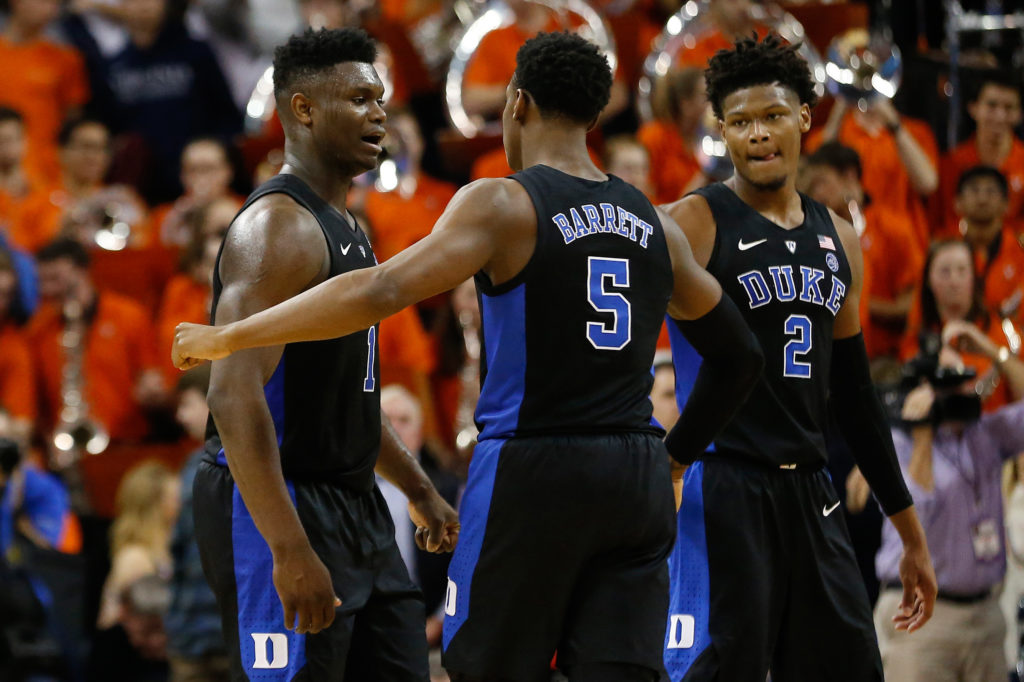
I may have totally buried the lede here. Covington’s return comes with negative externalities. Namely, Covington, when healthy, is really good, which is not great for a team that could use a couple of Ls to improve their standing in this spring’s NBA draft.
The league’s restructured lottery odds this season have a weird split that happens right between the ninth- and 11th-worst records in the league — a realistic area for the Wolves to fall. Finish ninth and your franchise has a 20.3 percent chance of jumping into the top four in the draft and 4.5 percent chance of landing the No. 1 pick. But slide down to 11th, which may be the difference of just a win or two, and those odds cut in half — a 9.4 percent chance of jumping into the top four in the draft and 2.0 percent chance of landing the No. 1 one pick.
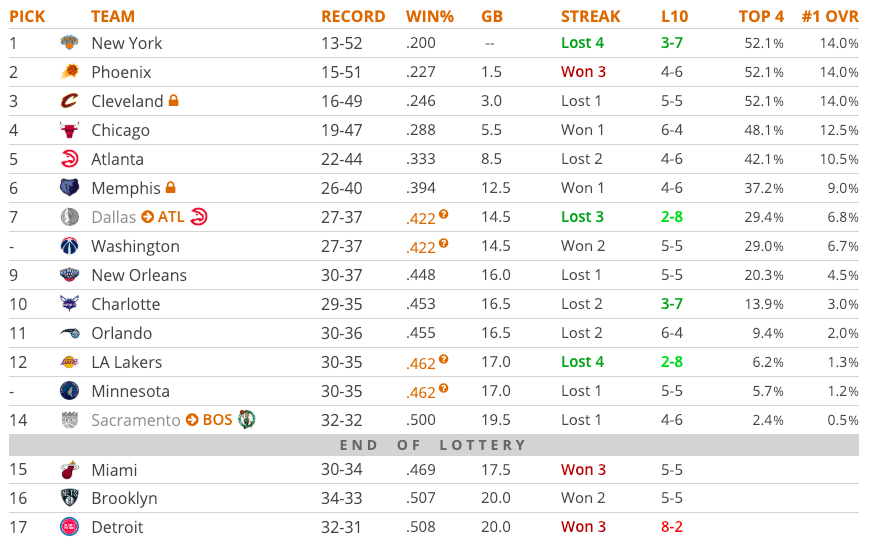
Conceivably, Covington’s presence alone could be the difference of a few wins down the stretch. For a Minnesota franchise between a rock and the hardest of places with their salary ledger, that’s unfortunate. Getting lucky and landing a star is one of the slim few opportunities for the Wolves to make move towards real contention.
A real question to ponder for a franchise that looks destined for a future on the treadmill of just-above-mediocrity: Is this their last chance to jump up in the lottery?
Towns isn’t slowing down any time soon, which likely means the playoffs — and thus no more lotteries — for much of the foreseeable future. Maybe the golden nugget of the season Jimmy busted could be a lottery-flavored gift. Wouldn’t that be great (and kinda fitting)?
There is certainly logic in craving as many ping-pong balls on lottery night. But here’s the rub: The people actually impacting the games that impact those odds don’t care. Saunders is battling for his life as a head coach. Every win helps him greatly… Towns has $32 million on the line, dependent on making an All-NBA this season. Only the naive would believe he prioritizes ping-pong balls over cash… And then there’s half the roster who is on expiring contracts. Those guys aren’t concerned about the franchise increasing their odds for Zion Williamson, RJ Barrett or Cam Reddish. No, the league has an individual incentive structure that prioritizes the immediate future.
I asked Saunders about how much he lets the possibility of Covington impact his mindset. His answer was specifically about Covington but extrapolate the logic out to the lottery as much as you see fit.
“I’m big on long-term goals, I’m big on short-term goals and I’m big on, if you wanna call them, midrange goals. But the short-term goals are, I believe, the most important thing,” said Saunders.
As it stands with 17 games remaining on the schedule, the short-term goals of this franchise, like it or not, are on what they can do change the stink that has lived on this 2018-19 season since Butler derailed it in September. For now, lottery odds be damned, the best way to instill change is to get their second-best player back. That’s the mindset. One way or the other, Covington’s presence will inspire all sorts of change — because that’s the most important thing.
